The value of resistance of an unknown resistor is calculated using the formula R=V/I where V and I are the readings of the voltmeter and the ammeter, respectivley. Consider the circuits below. The internal resistances of the voltmeter and the ammeter (RVandRG,respectively) are finite and nonzero.
 ,
,
Let RAandRB be the calculated values in the two cases A and B , respectively.
If the resistance of voltmeter is RV=1kΩ and the percentage error in the measurement of R (the value of R is nearly 10Ω)is
R>RA
R<RA
R=RB
dependent upon E and r.
The correct Answer is:A
a. RA=RA=R×RVR+RV<R
RB=R+R0>R
(Tough) % error in case A.
RA−RR×100=(RVR+RV−1)×100
RR+RV×100−1%
Percentage error in case B
RB−RR×100=RGR×100=10%
Hence, percentage error in circuit B is more than that in A.
Topper's Solved these Questions
- MISCELLANEOUS VOLUME 3Book:CENGAGE PHYSICS ENGLISHChapter:MISCELLANEOUS VOLUME 3Exercise:Interger Answer type
Explore 20 Videos
- MISCELLANEOUS VOLUME 3Book:CENGAGE PHYSICS ENGLISHChapter:MISCELLANEOUS VOLUME 3Exercise:Fill in the blanks
Explore 10 Videos
- MISCELLANEOUS VOLUME 3Book:CENGAGE PHYSICS ENGLISHChapter:MISCELLANEOUS VOLUME 3Exercise:Assertion and Reason Type
Explore 8 Videos
- MAGNETIC FIELD AND MAGNETIC FORCESBook:CENGAGE PHYSICS ENGLISHChapter:MAGNETIC FIELD AND MAGNETIC FORCESExercise:Multiple Correct Answer type
Explore 2 Videos
- MISCELLANEOUS VOLUME 5Book:CENGAGE PHYSICS ENGLISHChapter:MISCELLANEOUS VOLUME 5Exercise:Integer
Explore 11 Videos
Similar Questions
Two point charges q1=q2=2μC are fixed at x1=+3m and x2=−3m as shown in figure. A third particle of mass 1 g and charge q3=−4μC are released from rest at y=4.0m.Find the speed of the particle as it reaches the origin.
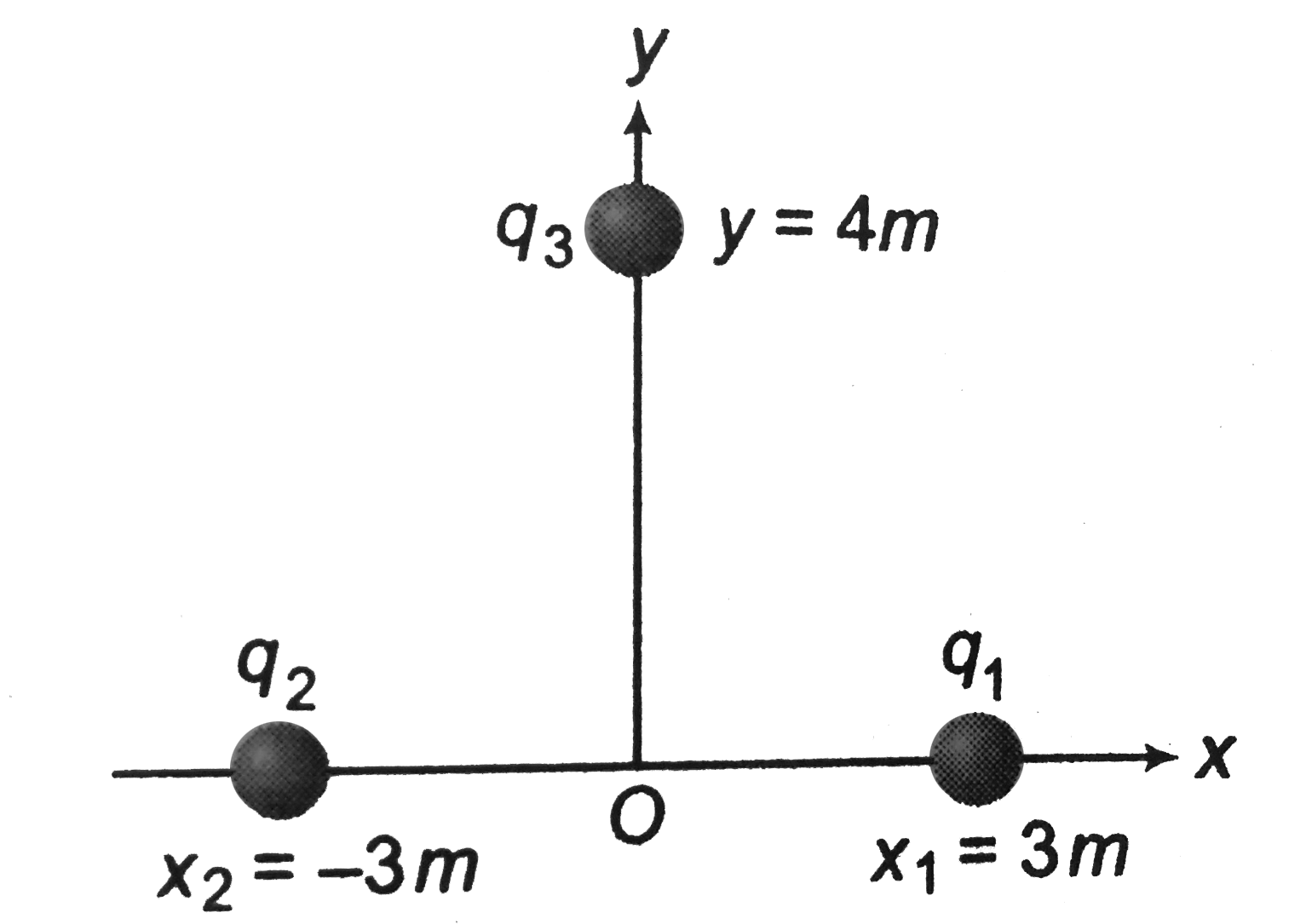
View SolutionFive identical capacitor paltes, each of area A, are arranged such that adjacent plates are at a distance d apart, the plates are connected to a source of emf V as shown in the figure
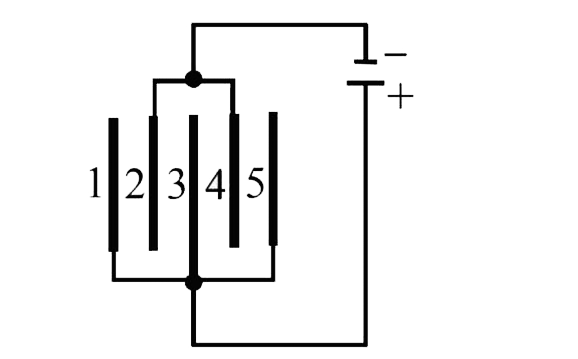
The charge on plate 1 is ………..and on plate 4 is.............
View SolutionStatement I: When air between the plates of a parallel plate condenser is replaced by an insulating dielectric medium, its capacity decreases.
Statement II: Electric field intensity between the plates with dielectric in between is reduced.
View SolutionWhich of the following statements is correct in the given figure?
Infinitely long wire at E kept perpendicular to paper carrying current inwards:

View SolutionA charged particle enters a uniform magnetic field with velocity v0=4m/s perpendicular to it, the length of magnetic field is x=(√32)R, where R is the radius of the circular path of the particle in the field. Find the magnitude of charge in velocity (in m/s) of the particle when it comes out of the field.
View SolutionThe value of resistance of an unknown resistor is calculated using the formula R=V/I where V and I are the readings of the voltmeter and the ammeter, respectivley. Consider the circuits below. The internal resistances of the voltmeter and the ammeter (RVandRG,respectively) are finite and nonzero.
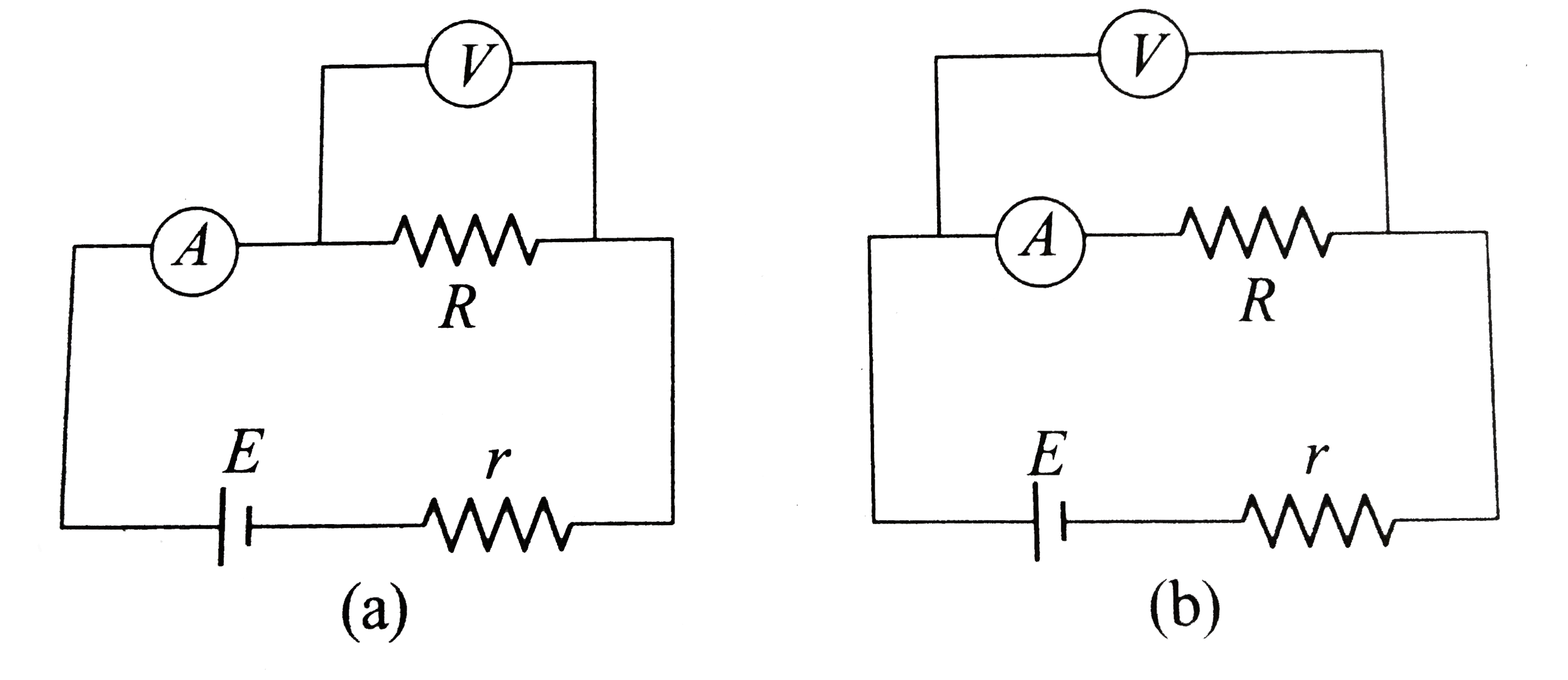 ,
,
Let RAandRB be the calculated values in the two cases A and B , respectively.
The relation between RA and the actual value of R is
View SolutionThe value of resistance of an unknown resistor is calculated using the formula R = V//I where V and I are the readings of the voltmeter and the ammeter, respectivley. Consider the circuits below. The internal resistances of the voltmeter and the ammeter (R_V and R_G, respectively) are finite and nonzero. , Let R_(A) and R_(B) be the calculated values in the two cases A and B , respectively. If the resistance of voltmeter is R_(V) = 1k Omega and the percentage error in the measurement of R (the value of R is nearly 10 Omega )is
View SolutionIn the, Ohm's law experiment to find resistance of unknown resistor R , following two arrangement ( a ) and ( b ) are possible. The resistance measured is given by R_(measured)=(V)/(i) V = voltage reading of voltmeter, i= current Reading of ammeter. But unfortunately the ammeters and voltmeter used are not ideal, but having resistance R_(A) and R_(V) respectively. You are given two resistor X and Y . Whose resistance is to be determined , using an ammeter of R_(A)=0.5Omega and a voltmeter of R_(V)=20 KOmega . It is known that X is in range of a few Ohm and Y is in range of several kilo ohm. Which of the circuit is preferable to measure X and Y -Resistor Circute
View SolutionIn the, Ohm's law experiment ot find resistance of unknown resistor R, the arrangement is as shown. The resistance measured is given by R_("measured")=(V)/(i)V= voltage reading of voltmeter. i=current reading of ammeter. The ammeters and the voltmeter used are not ideal, and have resistance R_(A) and R_(V) respectively. For arrangement shown, the meausred resistance is
View SolutionA voltmeter of resistance R_(V) and an ammeter of resistance R_(A) are connected as shown in an attempt to measure the resistance R . The measured value of the resistance is R_(M) = (V)/(I_(0)) where V is reading of voltmeter and I_(0) is reading of the ammeter. find the true value of the resistance in terms of R_(M), R_(V) and R_(A) .
View SolutionThe ammeter A reads 2A and the voltmeter V reads 20V, the value of resistance R is (Assuming finite resistance's of ammeter and voltmeter)
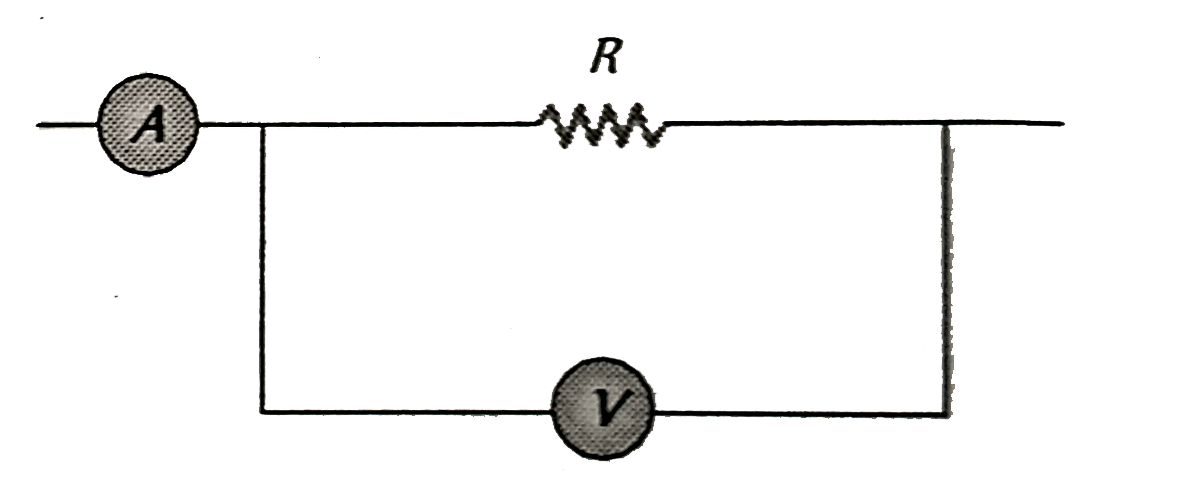
View SolutionConsider the two circuits P and Q, shown below, which are used 20 measure the unknown resistance R.

In each case, the resistance is estimated by using Ohm's law Rest=V/I, Where V and I are the readings of the voltmeter and the ammeter respectively. The meter resistances, Rv and RA are such that RA<<R<<Rv. The internal resistance of the battery may be ignored. The absolute error in the estimate of the resistance is denoted by δR=|R=Rest|.
View SolutionIn the Ohm'slaw experiment to find resistance of unknown resistor R following arrangements (a) and (b) are possible The resistance measured is given by R_(measured)=(V)/(i) V = voltage reading of voltmeter I = current Reading of ammeter But unfortunately the ammeters and voltmeter used are not ideal but having resistance R_(A) and R_(v) respect tively Yor are given two unknown resistors X and Y These resistances are to be determind using an ammeter of R_(A) = 0.5Omega and a voltmeter of R_(v) = 20kOmega It is known that X is in range of a few ohms and Y is in the range of several kilo ohm's Which circuit is perferable to measure X and Y {:("Resistor",Circuit),(x,(a)),(y,(b)):} .
View SolutionLet V and I be the readings of the voltmeter and the ammeter respectively as shown in the figure. Let R_(V) " and "R_(A) be their corresponding resistancce Therefore,
View SolutionResistance value of an unknown resistor is calculated using the formula R=V/I where V and I be the readings of the voltmeter and the ammeter respectively. Consider the circuits below. The internal resistances of the voltmeter and the ammeter ( R_v and R_B respectively ) are finite and non zero. Let R_A and R_B be the calculated values in the two cases A and B respectively. The relation between R_A and the actual value R is
View SolutionResistance value of an unknown resistor is calculated using the formula R=VI where V and I be the readings of the voltmeter and the ammeter respectively. Consider the circuits below. The internal resistances of the voltmeter and the ammeter (RvandRGrespectively ) are finite and non zero.
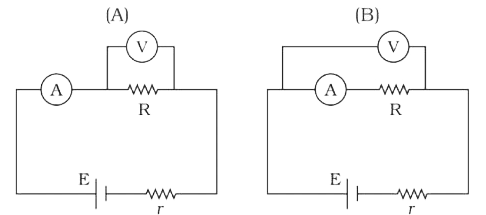
Let RvandRG be the calculated values in the two cases A and B respectively.
The relation between RBand the actual value of R is:
View Solution
